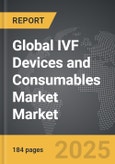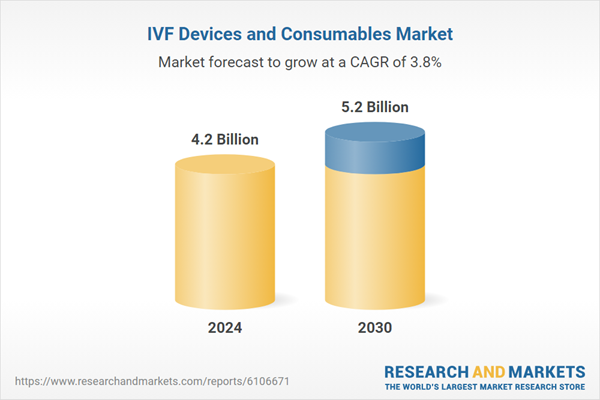Global IVF Devices and Consumables Market - Key Trends & Drivers Summarized
Why Are IVF Devices and Consumables Gaining Prominence in Reproductive Healthcare?
In vitro fertilization (IVF) devices and consumables have become a cornerstone of modern reproductive healthcare, offering hope to millions of couples worldwide facing infertility challenges. The rise in infertility rates, driven by factors such as delayed childbearing, lifestyle changes, environmental pollutants, and certain medical conditions, has increased the demand for assisted reproductive technologies. IVF, in particular, has become a widely accepted and accessible procedure, supported by both public and private healthcare institutions. The market encompasses a broad range of equipment and materials, including embryo culture dishes, incubators, micro-manipulation tools, cryopreservation systems, and media for fertilization and embryo transfer. The success of IVF treatments depends significantly on the precision and quality of these devices and consumables, as they facilitate the delicate processes of gamete manipulation, embryo development, and transfer. Increased awareness about fertility treatments, growing acceptance of single-parent and LGBTQ+ families seeking biological children, and the expansion of fertility clinics in both developed and emerging markets have fueled consistent market growth. Additionally, many nations are now offering financial support or insurance coverage for IVF treatments, reducing the financial barrier and encouraging more individuals to pursue reproductive assistance. As societal norms evolve and infertility becomes more openly discussed, the demand for advanced, reliable, and safe IVF products continues to rise, underscoring the market's critical role in shaping future demographics and reproductive autonomy.How Are Technological Advancements Enhancing IVF Success Rates and Market Demand?
Technological innovation is playing a pivotal role in improving IVF outcomes and expanding the market for IVF devices and consumables. Cutting-edge advancements such as time-lapse embryo imaging, AI-powered embryo selection, and high-resolution imaging techniques have enhanced the ability of clinicians to identify viable embryos, leading to higher success rates and fewer cycles needed per patient. Automation in laboratory equipment, including advanced incubators and micromanipulators, has also improved consistency and minimized human error. Cryopreservation techniques, particularly vitrification, have significantly improved survival rates of oocytes and embryos during storage, expanding options for delayed pregnancies and fertility preservation. Robotic systems and automated sperm analyzers are streamlining lab workflows, reducing variability and increasing throughput. Additionally, innovations in culture media composition and pH regulation technologies have optimized the embryonic environment, improving developmental outcomes. Consumables like sterile labware, single-use catheters, and embryo handling tools are increasingly being designed for greater precision, traceability, and contamination prevention. Cloud-based platforms for data tracking and patient management are enhancing transparency and customization of treatment protocols. These advancements have made IVF not only more effective but also safer and more accessible, attracting a broader patient base. Clinics are now able to offer personalized fertility treatments, catering to complex cases involving genetic screening, recurrent implantation failure, or age-related fertility decline. As technologies continue to evolve, the adoption of next-generation IVF devices and consumables is expected to accelerate, positioning the market for robust and sustained growth across both clinical and consumer-facing fertility care segments.How Do Regional and Demographic Trends Shape the Demand for IVF Devices and Consumables?
Regional disparities in fertility rates, healthcare infrastructure, cultural attitudes, and regulatory policies significantly influence the demand for IVF devices and consumables across global markets. In high-income regions such as North America and Western Europe, rising maternal age, dual-career households, and access to advanced medical care have fueled demand for assisted reproductive technologies. Countries like the United States, Germany, and the United Kingdom have well-established fertility industries supported by robust insurance frameworks and widespread availability of cutting-edge IVF technologies. In Asia-Pacific, rapid urbanization, increasing infertility rates, and expanding middle-class populations are driving a surge in fertility clinic development and treatment uptake, particularly in countries like India, China, Japan, and South Korea. Government initiatives to counter declining birth rates and favorable reimbursement policies are supporting this growth. Meanwhile, in the Middle East and parts of Africa, cultural openness toward fertility interventions is growing, albeit at varying paces depending on religious and social contexts. These regions are beginning to invest in fertility infrastructure and trained professionals, which will eventually lead to increased demand for high-quality devices and consumables. Latin America is witnessing gradual growth fueled by private clinics and medical tourism. Across all regions, there is a marked increase in the number of fertility centers, embryologists, and gynecologists specializing in reproductive medicine. Moreover, younger generations are showing greater openness to fertility preservation through egg and sperm freezing, expanding the consumables market for cryogenic and storage solutions. As global awareness increases and barriers to care diminish, demographic and regional trends will continue to shape a diverse, geographically expansive IVF market ecosystem.What Factors Are Driving the Continued Growth of the IVF Devices and Consumables Market?
The growth in the IVF devices and consumables market is driven by several interconnected factors tied to demographic shifts, medical advancements, policy developments, and consumer behavior. One of the most powerful drivers is the global rise in infertility, spurred by changing lifestyles, increasing stress levels, late marriages, and conditions such as polycystic ovarian syndrome and endometriosis. Growing awareness and acceptance of assisted reproductive technologies have led to greater patient volumes at fertility clinics, both in urban centers and increasingly in secondary cities. The trend toward delayed parenthood, particularly among professional women, has led to an upsurge in demand for egg freezing and fertility preservation, bolstering the need for cryopreservation devices and media. Public and private healthcare entities are increasingly offering subsidies or mandating insurance coverage for IVF treatments, expanding access across socioeconomic strata. Technological improvements in lab automation, embryo selection, and gamete storage have enhanced success rates, making IVF a more attractive and viable option. Furthermore, the entry of private equity and healthcare investors into the fertility sector has fueled the establishment and expansion of fertility centers globally, increasing the market's absorptive capacity for devices and consumables. Cross-border reproductive care and fertility tourism have also added new customer segments, particularly in regions offering cost-effective, high-quality IVF services. Digital marketing and social media campaigns by clinics and fertility influencers are reshaping patient education and driving demand. As consumer expectations rise and fertility becomes a longer-term health consideration, the demand for reliable, effective, and technologically sophisticated IVF devices and consumables is set to remain on an upward trajectory globally.Report Scope
The report analyzes the IVF Devices and Consumables market, presented in terms of market value (US$). The analysis covers the key segments and geographic regions outlined below:- Segments: Product Type (Culture Media & Reagents, Accessories & Disposables, Instruments).
- Geographic Regions/Countries: World; United States; Canada; Japan; China; Europe (France; Germany; Italy; United Kingdom; Spain; Russia; and Rest of Europe); Asia-Pacific (Australia; India; South Korea; and Rest of Asia-Pacific); Latin America (Argentina; Brazil; Mexico; and Rest of Latin America); Middle East (Iran; Israel; Saudi Arabia; United Arab Emirates; and Rest of Middle East); and Africa.
Key Insights:
- Market Growth: Understand the significant growth trajectory of the Culture Media & Reagents segment, which is expected to reach US$3.5 Billion by 2030 with a CAGR of a 4.3%. The Accessories & Disposables segment is also set to grow at 3% CAGR over the analysis period.
- Regional Analysis: Gain insights into the U.S. market, valued at $1.1 Billion in 2024, and China, forecasted to grow at an impressive 7.2% CAGR to reach $1.1 Billion by 2030. Discover growth trends in other key regions, including Japan, Canada, Germany, and the Asia-Pacific.
Why You Should Buy This Report:
- Detailed Market Analysis: Access a thorough analysis of the Global IVF Devices and Consumables Market, covering all major geographic regions and market segments.
- Competitive Insights: Get an overview of the competitive landscape, including the market presence of major players across different geographies.
- Future Trends and Drivers: Understand the key trends and drivers shaping the future of the Global IVF Devices and Consumables Market.
- Actionable Insights: Benefit from actionable insights that can help you identify new revenue opportunities and make strategic business decisions.
Key Questions Answered:
- How is the Global IVF Devices and Consumables Market expected to evolve by 2030?
- What are the main drivers and restraints affecting the market?
- Which market segments will grow the most over the forecast period?
- How will market shares for different regions and segments change by 2030?
- Who are the leading players in the market, and what are their prospects?
Report Features:
- Comprehensive Market Data: Independent analysis of annual sales and market forecasts in US$ Million from 2024 to 2030.
- In-Depth Regional Analysis: Detailed insights into key markets, including the U.S., China, Japan, Canada, Europe, Asia-Pacific, Latin America, Middle East, and Africa.
- Company Profiles: Coverage of players such as Atos S.E., BMC Software, Broadcom Inc. (CA Technologies), Capgemini SE, Cisco Systems, Inc. and more.
- Complimentary Updates: Receive free report updates for one year to keep you informed of the latest market developments.
Some of the 43 companies featured in this IVF Devices and Consumables market report include:
- Cook Medical
- CooperSurgical
- Cryo Bio System
- Esco Medical
- Fertility Technology Solutions
- FUJIFILM Irvine Scientific
- Genea Biomedx
- Hamilton Thorne
- IVFtech
- Kitazato Corporation
- Labotect GmbH
- Merck KGaA
- Nidacon International
- Origio (part of CooperSurgical)
- Progyny
- Rocket Medical
- Smiths Medical
- The Baker Company
- Thermo Fisher Scientific
- Vitrolife
This edition integrates the latest global trade and economic shifts into comprehensive market analysis. Key updates include:
- Tariff and Trade Impact: Insights into global tariff negotiations across 180+ countries, with analysis of supply chain turbulence, sourcing disruptions, and geographic realignment. Special focus on 2025 as a pivotal year for trade tensions, including updated perspectives on the Trump-era tariffs.
- Adjusted Forecasts and Analytics: Revised global and regional market forecasts through 2030, incorporating tariff effects, economic uncertainty, and structural changes in globalization. Includes historical analysis from 2015 to 2023.
- Strategic Market Dynamics: Evaluation of revised market prospects, regional outlooks, and key economic indicators such as population and urbanization trends.
- Innovation & Technology Trends: Latest developments in product and process innovation, emerging technologies, and key industry drivers shaping the competitive landscape.
- Competitive Intelligence: Updated global market share estimates for 2025, competitive positioning of major players (Strong/Active/Niche/Trivial), and refined focus on leading global brands and core players.
- Expert Insight & Commentary: Strategic analysis from economists, trade experts, and domain specialists to contextualize market shifts and identify emerging opportunities.
Table of Contents
Companies Mentioned (Partial List)
A selection of companies mentioned in this report includes, but is not limited to:
- Cook Medical
- CooperSurgical
- Cryo Bio System
- Esco Medical
- Fertility Technology Solutions
- FUJIFILM Irvine Scientific
- Genea Biomedx
- Hamilton Thorne
- IVFtech
- Kitazato Corporation
- Labotect GmbH
- Merck KGaA
- Nidacon International
- Origio (part of CooperSurgical)
- Progyny
- Rocket Medical
- Smiths Medical
- The Baker Company
- Thermo Fisher Scientific
- Vitrolife
Table Information
| Report Attribute | Details |
|---|---|
| No. of Pages | 184 |
| Published | December 2025 |
| Forecast Period | 2024 - 2030 |
| Estimated Market Value ( USD | $ 4.2 Billion |
| Forecasted Market Value ( USD | $ 5.2 Billion |
| Compound Annual Growth Rate | 3.8% |
| Regions Covered | Global |









